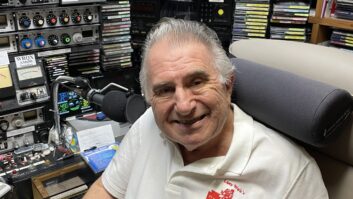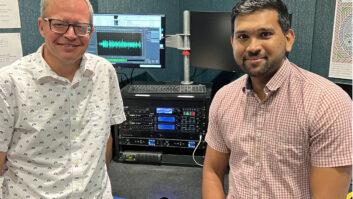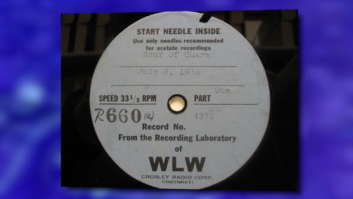
Nothing New Under the Sun
A recent Radio World story on the 30th anniversary of the invention of the compact disc (“From Pinkeltje to Ubiquity: CD Turns 30,” May 20) prompted me to compare the CD with my grandfather’s first analog disc. He was Emile Berliner, inventor of the microphone and the disc-playing gramophone, which made voice and music broadcasting possible.
The similarities are incredible. Take a look at the 1996 CD from Deutsche Grammophon (a label founded and named by Emile and once owned by CD inventor Philips Co.) and the Berliner Gramophone Co. 1889 disc.
- They’re the same size (approximately 5 inches in diameter)
- They each have a center hole
- They’re “single face” (recorded on one side only)
- There’s no paper label (contrary to that found on “78s”)
- The CD is recorded on the bottom (as specified in the Berliner 1887 patent, though even Emile didn’t record that way)
- The CD is inside-start (as shown in the patent, and innumerable radio transcriptions were recorded thusly)
- The recordings are in the form of a spiral, the CD with pits, the analog with a groove
- The CD is replicated on a press, just like the analog disc (Emile Berliner’s invention for mass-producing unlimited perfect copies of a single master recording created today’s recorded music industry)
But there’s one big difference between the two discs: The Berliner analog disc will be playable a hundred years from now. The CD won’t be.
Oliver Berliner
Bozman, Md.
WAMU Multicasting
Mark, the reason you’ll never hear “Go to WAMU Dot Org to print out your 25 percent off coupon to purchase an HD Radio from Best Buy this week only” is that it would (probably) be illegal for WAMU to do so (“Why Should I Buy an HD Radio,” July 15).
They’re a noncommercial station, and that one sentence violates all three of the core no-no’s for noncoms: price info, inducement to buy/sale info and calls to action.
It’s possible that if there was no fiscal connection/relationship whatsoever between Best Buy and WAMU, it might be legal, but it certainly would sound weird for a noncom to be so blatantly shilling for a business, especially a for-profit. That’s rather a no-no in the noncomm world … listeners would probably be too annoyed for it to be worth it.
Aaron Read
General Manager
WEOS(FM)
Geneva, N.Y.
Mark Lapidus replies: Very true Aaron, and since I used to write those “non-commercial” commercials about 30 years ago at WOUB in Athens, Ohio, I should have remembered that! I believe we called them under-writing announcements. I’m sure a clever wordsmith could construct such a statement that follows the rules but still communicates the message from 88.1 to 91.9! Thanks for reading RW and for catching my error.
Little Pitchers Have Big Ears
Radio is a dying medium. Or at least that’s what I’m told.
I don’t believe it one bit. A recent experience reconfirmed my belief that children are listening to the local terrestrial as opposed to their MP3 player or on the Web.
My son was a first grader this spring at Chandler Elementary. His teacher, Ms. Jackson, allows each student to be Star of the Week during the school year. This is an opportunity for the child to tell a little about his or her interests or hobbies and for the other children to learn something extra about one of their classmates.
It was my son’s turn and I was given the opportunity to speak to his class. I walked into class with a hand-truck full of beacon, an incandescent unit that I had in my garage. (Rest assured, I took one of the bulbs out before I brought it into class because I knew that they would ask me to plug it up.)
I walked into the room and set the dolly down and purposefully said nothing. They asked what it was; I responded by asking what they thought it might be. Finally one little boy had figured it out. “Is it a can opener?” I haven’t laughed that hard in a long time.
“Great guess, but no,” I told him. I explained what exactly I had brought with me, and told them that I was chief engineer for six radio stations and that it was my job to keep them on the air.
Then I pulled out several pictures of our air studios. The first set I showed was of our country station.
Suddenly a group of jingle singers that I must not have noticed when I’d walked into the classroom began to sing the station jingles in a choir of little voices. This made me smile.
The next set of pictures was from our heritage CHR. Again, familiar music burst out in the classroom. Somehow I’d missed two sets of jingle singers in the room.
I displayed the third batch of pictures, this time of our heritage AC station. I said that their parents or grandparents may listen to this particular station — at which point one little girl in the middle of the pack belted out the weather jingle. Then in her best radio voice she said, “A service of South Central Radio Group!”
Hilarious. She’d actually committed to memory a phrase that is buried inside of a legal ID played once an hour.
These kids knew more about our stations than I would have ever expected. Proof of radio’s viability? Maybe not. But it is a positive indicator that the next generation is interested and actually listening.
Jeff Yates
Chief Engineer
Evansville Radio Group
South Central Media
Evansville, Ind.












